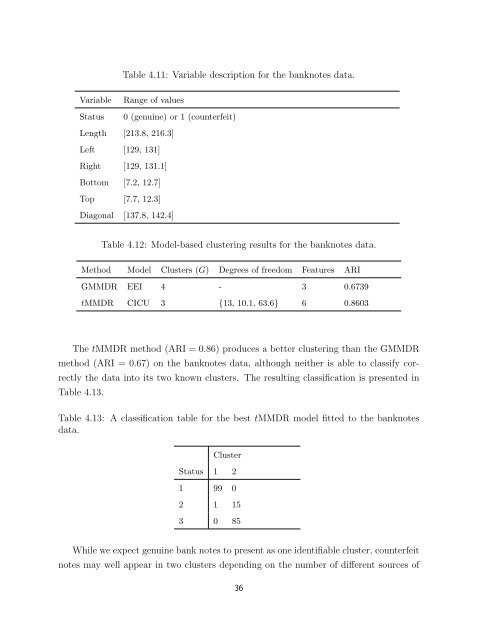Dimension Reduction for Model-based Clustering via Mixtures of ...
Dimension Reduction for Model-based Clustering via Mixtures of ...
Dimension Reduction for Model-based Clustering via Mixtures of ...
You also want an ePaper? Increase the reach of your titles
YUMPU automatically turns print PDFs into web optimized ePapers that Google loves.
Table 4.11: Variable description <strong>for</strong> the banknotes data.VariableStatusRange <strong>of</strong> values0 (genuine) or 1 (counterfeit)Length [213.8, 216.3]Left [129, 131]Right [129, 131.1]Bottom [7.2, 12.7]Top [7.7, 12.3]Diagonal [137.8, 142.4]Table 4.12: <strong>Model</strong>-<strong>based</strong> clustering results <strong>for</strong> the banknotes data.Method <strong>Model</strong> Clusters (G) Degrees <strong>of</strong> freedom Features ARIGMMDR EEI 4 - 3 0.6739tMMDR CICU 3 {13, 10.1, 63.6} 6 0.8603The tMMDR method (ARI = 0.86) produces a better clustering than the GMMDRmethod (ARI = 0.67) on the banknotes data, although neither is able to classify correctlythe data into its two known clusters. The resulting classification is presented inTable 4.13.Table 4.13: A classification table <strong>for</strong> the best tMMDR model fitted to the banknotesdata.ClusterStatus 1 21 99 02 1 153 0 85While we expect genuine bank notes to present as one identifiable cluster, counterfeitnotes may well appear in two clusters depending on the number <strong>of</strong> different sources <strong>of</strong>36
















